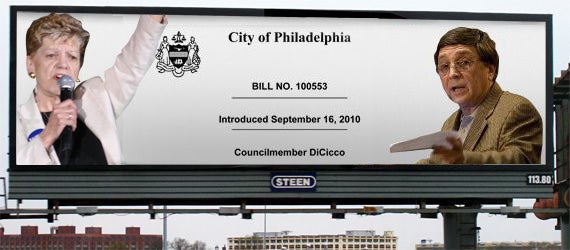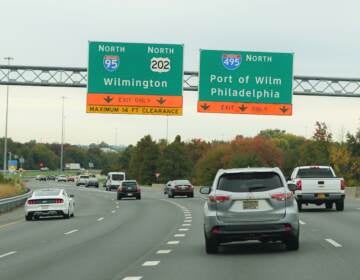City Council to consider allowing relocation of billboards condemned in I-95 expansion

A revamped version of a controversial bill, which would allow many billboards standing on land acquired by PennDOT for the I-95 expansion project to be automatically relocated, passed city council’s rules committee and heads to full council for a vote.
The original version raised concerns among neighborhood groups, the anti-blight organization SCRUB, city planners and PennDOT. Planners thought the first version overrode existing zoning by allowing the billboards to be located anywhere within 300 feet of their existing locations in a corridor measuring 200 feet from either side of the new highway boundaries, regardless of the zoning in the new spot.
SCRUB and community groups worried that traditional billboards would be replaced with digital ones, which they said would create a driving hazard. And there were also worries that as it had been written, the legislation would threaten federal highway funding.
The new version places restrictions on how and where a billboard can be moved. It says that the relocated sign cannot be a digital billboard, that the new site must be zoned either industrial or commercial, and that it is not illuminated by lights of “such intensity or brilliance as to cause glare or impare the vision of a driver of any vehicle.”
The new version also exempts billboards along a good chunk of I-95, the portion within the Sixth Councilmanic District. Sixth District Councilwoman Joan Krajewski, who has opposed the legislation for most of its long history, made good on her promise to amend the bill to exempt her district if it progressed toward a council vote.
But with the new language, planning commission staff no longer oppose the bill, and staff will be recommending that the Planning Commission not oppose the bill at its June 14 meeting, said Planning Commission Executive Director Gary Jastrzab.
“The purpose of this amendment is to limit the areas available for relocation of signs, require that they relocated to parcels zoned commercial or industrial only, and further require that they meet other restrictions in the city’s current zoning code,” Jastrzab testified.
Representatives of major outdoor advertisers, including Steen, CBS and ClearChannel’s outdoor divisions, said the amendment was fine with them, as nothing that it limits was ever their intent, anyway. Keeping billboards means keeping jobs, tax revenue, and the free advertising they provide to non-profits, they said.
After testifying, Attorney George Kroculick, Steen President Terry Steen, CBS Outdoor landlease Manager Charles Fertonardo, and several other industry representatives said the new locations for the displaced billboards are very close to their current locations, and should the bill pass, no one driving on I-95 will notice any difference. But it will make a huge difference to those who own the billboards or receive rental fees from a billboard company, Steen said.
“When they built 95 in the early ’70s through Kennsington, Fishtown and Torresdale, we lost a lot of businesses and most never came back,” Steen said. This bill would help ensure that didn’t happen again, he said.
But some neighborhood groups and SCRUB are not appeased by the amendment. SCRUB Staff Attorney Stephanie Kindt testified that the expansion of I-95 “is a unique opportunity to clear the clutter of ugly signage from Philadephia’s Northeast gateway” and that the bill takes away that opportunity. She said that city zoning law clearly states that a sign that is a nonconforming use cannot be rebuilt, and this bill would provide a way around that. Kindt said that sign owners will be compensated for the loss of their signs by the state.
The original version of the legislation was opposed by the planning commission last fall. It made it to the rules committee hearing calendar last November, but was pulled from the agenda. Planners thought the proposal was dead. So did Sean McMonagle, legislative aide to the bill’s sponsor, First District Councilman Frank DiCicco.
The removal from the November calendar occurred because Krajewski vowed to amend the legislation by removing her district from it if it moved forward.
See earlier coverage for the full backstory, but in short, Krajewski’s chief of staff, Chris Creelman, and McMonagle, told PlanPhilly in late September 2010 that the first version of the bill originated with Steen. (Tuesday, attorney Kroculick said a group of outdoor advertising industry representatives worked with PennDOT”s local District 6 on the first version of the bill, and the new version was a “collaborative effort between the city, PennDOT and the outdoor advertisers affected” by the I-95 project.)
Last fall, Creelman said Steen approached Krajewski’s office about introducing the legislation, but she wanted to talk to planning and other city staffers before doing so. The next thing she knew, DiCicco was introducing the legislation.
McMonagle said that DiCicco was introducing the legislation to get a conversation started, but did not necessarily support the bill as originally written.
When Krajewski learned about the bill – and heard opposition to it from the community organizations in her district – she pledged to amend her district out of the bill’s jurisdiction. That’s when the original bill stalled in committee.
McMonagle said then the bill would only apply to a few billboards if Krajewski’s district was not part of it.
But Kroculick said Tuesday that wasn’t so. He said PennDOT isn’t precisely sure how many billboards are in the way of expansion, but it’s about 70 faces. (A two-sided billboard has two faces, a one-sided billboard has one.) Under the revamped guidelines in DiCicco’s amendment, 17 faces could not be replaced, Kroculick said. Krajewski’s amendment taking out her district would cost the industry another 5 faces, he said.
When asked about it, McMonagle said it sounded like the industry folks “got it backwards” and that there would be 5 faces that would not be impacted by Krajewski’s exemption. When DiCicco was asked about the numbers, he referred to the stats given during the industry representative’s testimony.
If the amended version of the bill passes, the owners of any impacted billboards in Krajewski’s office would have to go through the same process to move the billboard as they would trying to put up a totally new one.
Creelman said in an email Tuesday that he was unaware that DiCicco had proposed the amendment to the bill that made planning feel better about it, but he said he doubts it would make any difference to his boss “since there is strong community opposition to the proposal from our district.”
Contact the reporter at kgates@planphilly.com.
WHYY is your source for fact-based, in-depth journalism and information. As a nonprofit organization, we rely on financial support from readers like you. Please give today.






